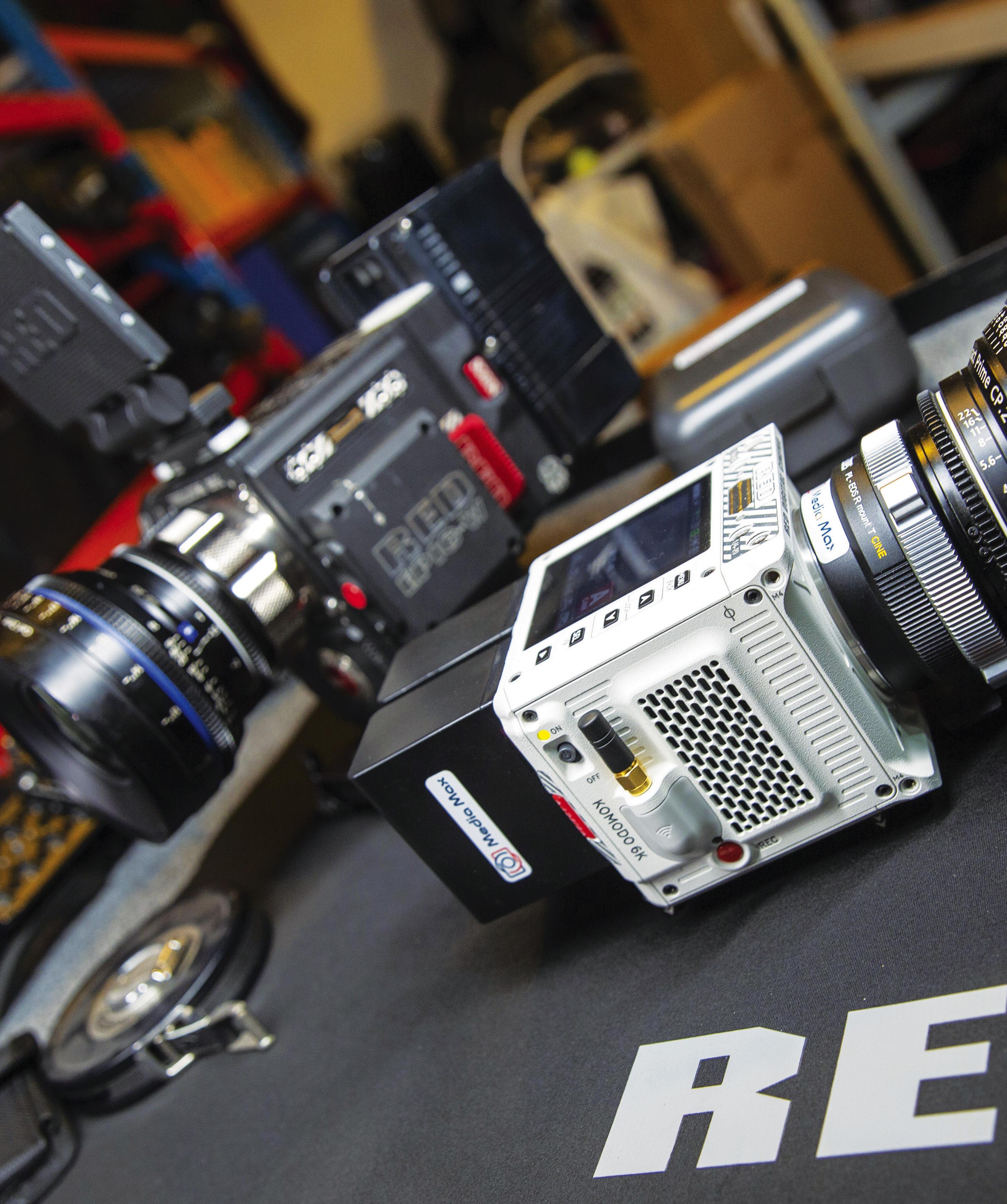
13 minute read
ALL CHARGED UP
ALL FIRED UP TO USE THE RED KOMODO
The RED Komodo is one of the year’s most anticipated products – it promises 6K, is a small form factor cinema camera, and is the most costeffective piece of kit to emerge from the RED stable. Freelance DoP Andrew Clemson and focus puller Koko Boutchakjian take it for a field test
The Komodo is a far cry from the original Red One or even the DSMC1/2 series of cameras. A tiny cube, very similar in form factor to a Z-Cam, it weighs under 1kg unrigged on its own and features a 6K global shutter sensor with a brand new colour science. The global shutter alone is enough to make this model interesting to most people, allowing more natural action and elimination issues with strobing light, but the new sensor also performs particularly well in terms of highlight roll-off.
Like all RED cameras since the introduction of the EPIC, the Komodo is modular. This allows people to design their rigs from the ground up to suit the nature of the content they plan to capture.
One of the most interesting aspects of the new design is that it has done away with one of my personal pet peeves over the years, RED cameras’ lack of support for third-party media. The Komodo accepts CFAST2.0 memory, which is usable across a number of different cameras, making it a boon for rental houses that don't want to invest too heavily in one type of card.
Like its larger siblings, the Komodo records both Redcode Raw and ProRes to the internal cards at resolution and framerate combinations, with record times dictated by the option you choose. At the highest quality, you’ll get just under an hour of material per TB.
The Komodo is the first RED camera to feature a built-in screen for monitoring. Like the rest of the camera, it’s tiny,
so not much use for focus (even though it does have peaking), but in a pinch you can certainly use it for framing, fantastic in a crash cam situation. The Komodo also features full 4K out via a 12G SDI port, which gives you the option to record to an offboard monitor or recorder for proxies, backup record or just use instead of internal memory if you have a lot of SSDs for long interview situations.
The last way to monitor is via an ad-hoc WiFi network straight to your phone or tablet. While there is (very low) latency, I’d say this is more for framing or remote viewing than for real-time focus.
When I first heard of the lens mount choice on the Komodo, I had no experience with RF lenses so was a bit surprised, but having seen what it allows the camera to do, I’m an instant convert. The brain features a Canon RF mount, previously seen on Canon’s mirrorless range of stills/hybrids. With a similar shallow flange depth to the ever-popular MFT and E-Mounts, this offers the same adaptability in the form of mount adapters, to allow electronic control of a whole range of lenses. I’ve shot projects on the Komodo using both EF lenses and PL mount cinema lenses, but you really can’t discount the RF lenses that work natively.
The Komodo autofocus is fantastic. Using Phase Detect AF, you can use native RF (and EF via an adapter) lenses to track subjects and maintain autofocus. I haven't tried the native lenses, but I can only assume they work faster than the EF we had via adapter.
Taking another nod from Prosumer cameras, the Komodo has two power slots on the back that accept BP batteries. While that would spark alarm in the larger RED cameras, the Komodo has very low power consumption in comparison, allowing around two hours of operation on a single charge when using a larger capacity BP battery.
The two slots double this capacity and allow hot swapping. You can, of course, use a V-Lock battery via an adapter, for even longer run times and power accessories via D-Tap – around five or six hours with a

Andrew Clemson says the Komodo is an ideal choice for a first-time RED buyer. “If you’re shooting for 4K native delivery or just want to run with the smallest camera package possible for high-intensity shooting without rolling shutter issues, the Komodo is your answer”
Andrew Clemson, DoP
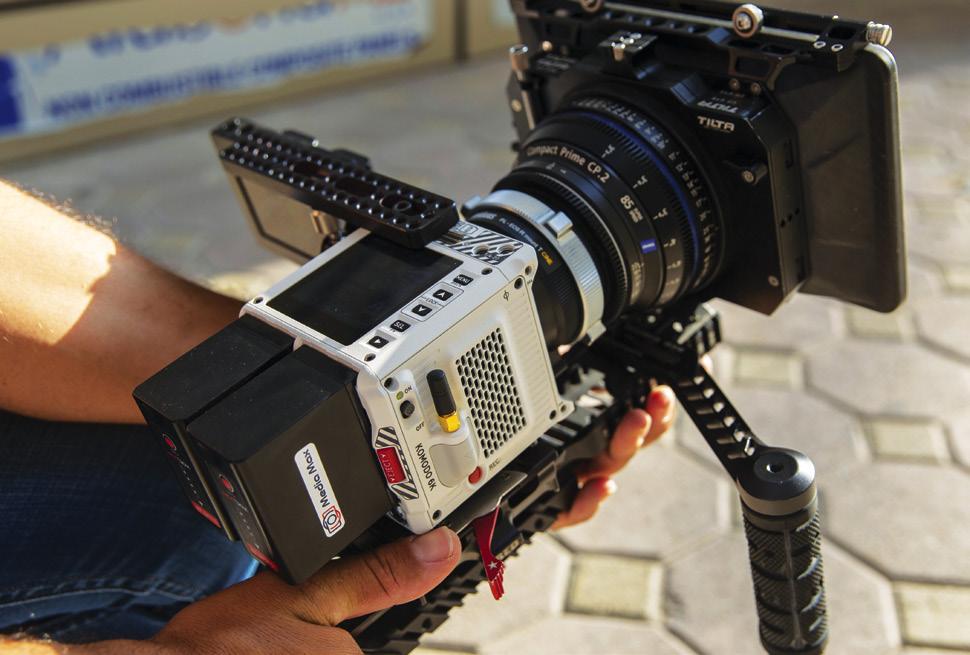
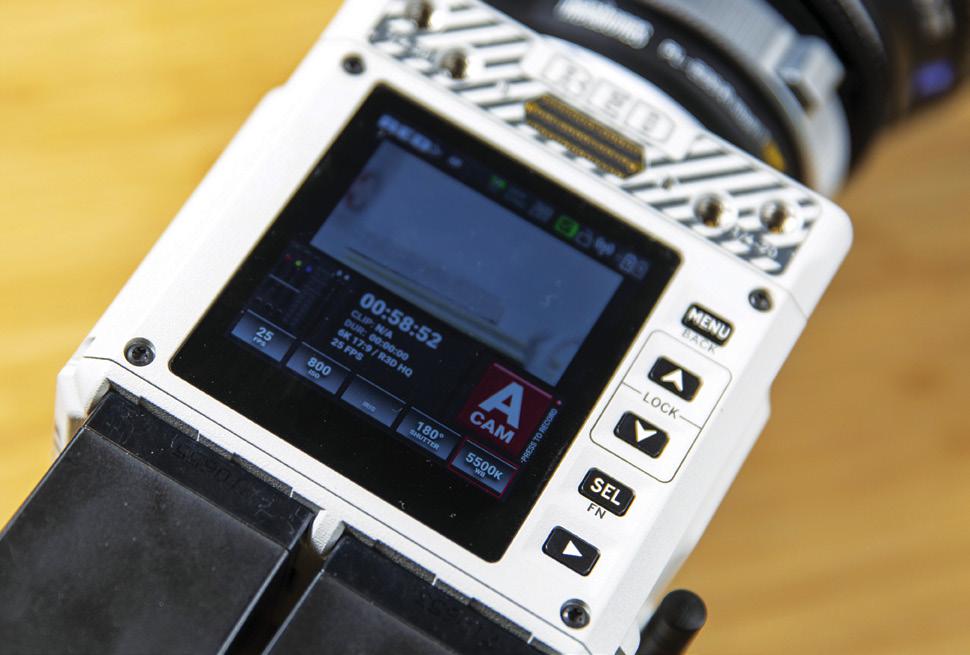


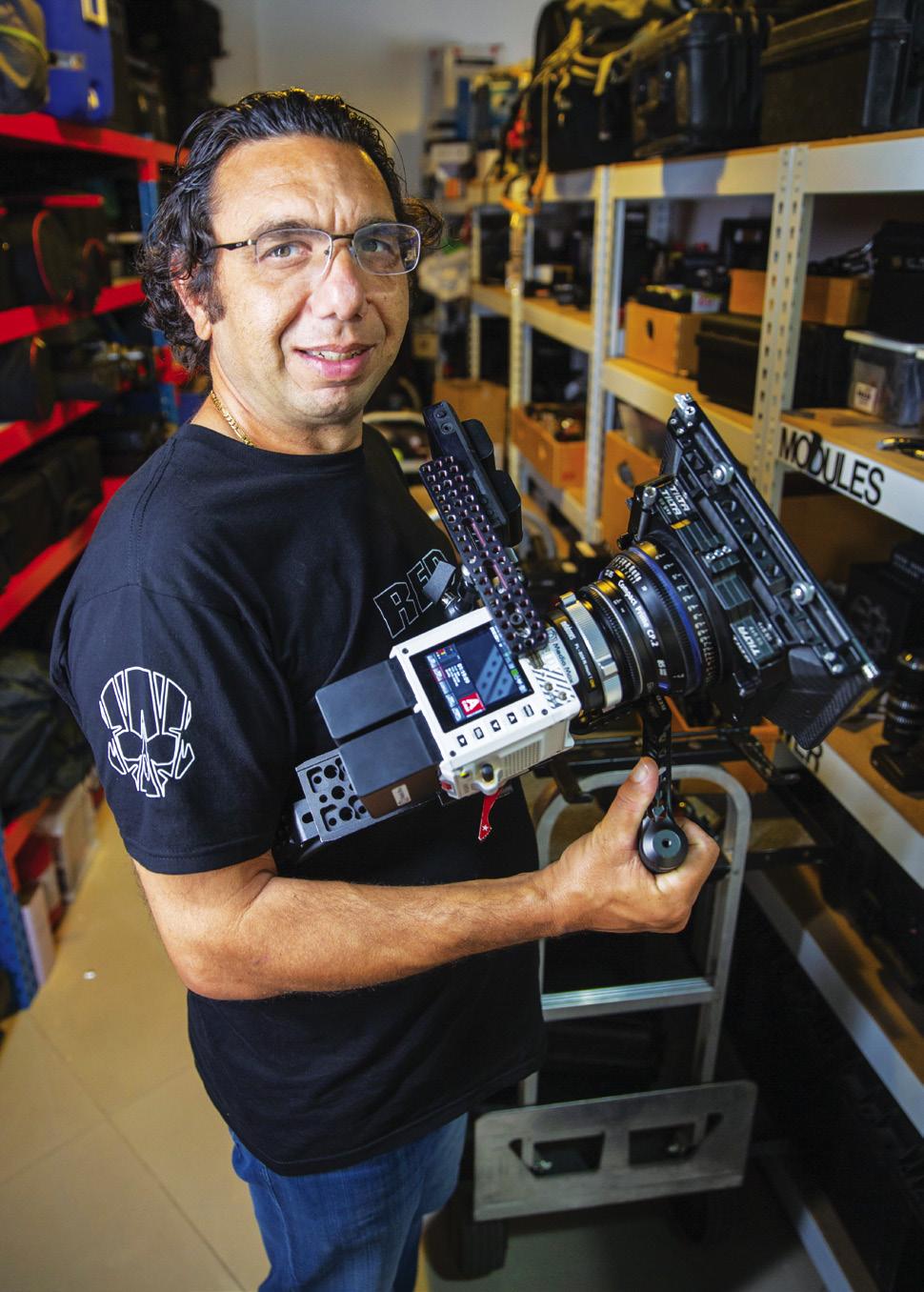
larger capacity battery, absolutely crazy for a cinema camera.
Audio-wise, the Komodo has only one 3.5mm jack. This is unsurprising given its size and real strength as a crash/action camera. You can feed a scratch mic into the brain to capture audio, but you would want to capture any important audio via an external recorder and sync.
The camera itself is very quiet. I actually found my Atomos monitor to be much louder, which is very surprising for a RED! The real strength of the Komodo is the fact that it is so compact and portable. Though once you throw in V-Lock batteries, PL mount lenses, matte boxes and other KAS, you find yourself in the same size and weight territory as with one of the larger DSMC2 cameras.
I have a RED Gemini, and during the shoots on which I’ve used the Komodo, I didn’t feel any real difference between the two. But, when using the native batteries and a small prime lens, it’s small enough to be used like a DSLR, or on one-hand gimbals like the Ronin-S.
So that brings me to the real question. Will this replace the other RED cameras in the wild?
This comes down to a few factors. Is this the only RED you have access to? What kind of material are you be shooting, and how do you need to capture it?
The answer, when you look at all these factors, is no.
Each RED camera has a unique role. The Komodo is a 6K camera with the ability to capture footage up to 40FPS. If you need to capture footage at a higher resolution, the Helium or Monstros (which also gives you a fullframe option) are still necessary. The sensor, while working admirably, is not as good as the Gemini in low light.
But if you’re shooting for 4K native delivery or just want to run with the smallest camera package possible for high-intensity shooting without rolling shutter issues, the Komodo is your answer. I can also see it as a mainstay for remote documentary filming, due to the ability to carry multiple days of power and media in a single backpack.
It can of course be an A camera in most situations if needed. The Komodo still shoots 6K resolution Redcode Raw and will no doubt become an indie film darling. For people wanting to get into the RED ecosystem, the Komodo is an obvious choice, given its absurdly low price point. If you’re already a RED owner, it can be an unbeatable B or C camera, rather than an outright replacement. But if I was buying a RED for the first time? The Komodo in a heartbeat.
Koko Boutchakjian, focus puller and owner of Media Max
Koko Boutchakjian was one of the first to invest in a Red Komodo in the UAE.
Andrew Clemson and Koko Boutchakjian are both passionate camera experts based in Dubai.


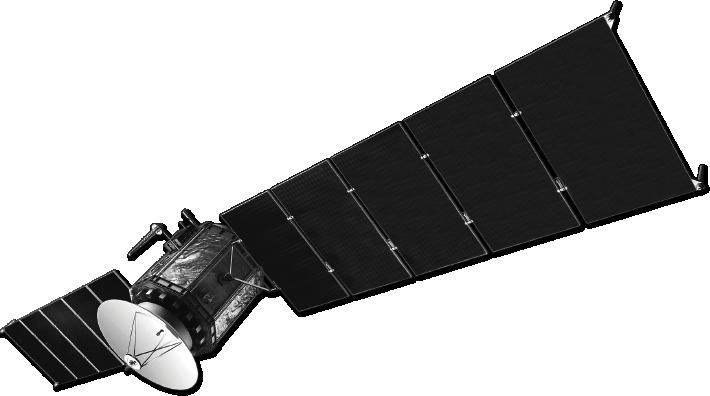
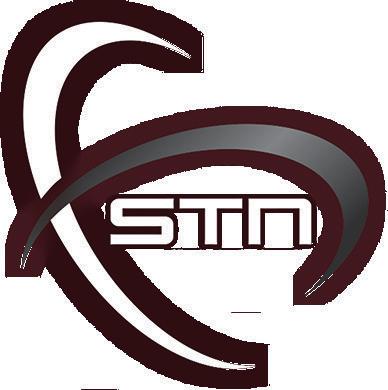
Ross announces Inception
Ross has announced that V15 of Inception, its newsroom computer system (NRCS) and social media management tool, is now available to customers. This latest release includes a range of new features, with a focus on two key areas: Assignment Manager enhancements and MOS device permissions.
New features help improve planning, including the introduction of duration-based, all-day and multi-day events. There is also improved visibility of timing information for content created in the Assignment Manager and increased search capabilities to allow better planning and communication.
Version 15 adds the option to set user permissions by MOS device, meaning some users may be able to create and modify MOS objects for all configured devices, with others given more limited access. This allows more granularity in workflows and is powerful in an enterprise environment where multiple teams may be using the same Inception instance.
These features were developed and prioritised with input from existing Inception users.
www.rossvideo.com
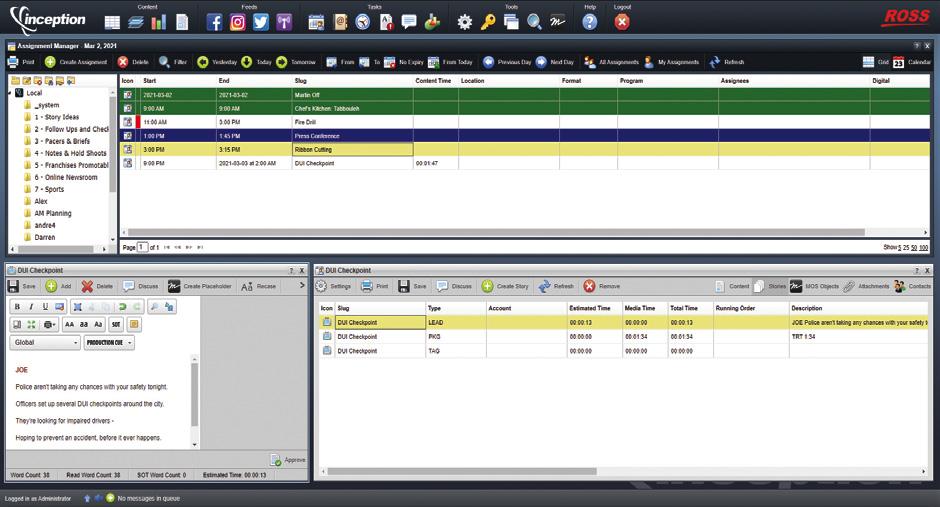
ARRI creates COVID-ready workflow toolkit
ARRI has released a new toolkit called Remote Solutions that can be customised to meet near-set and off-set workflows. This remote production ecosystem allows professionals to safely and immediately get back to work without compromising operational and creative control.
With a complete system of connected ARRI cameras, lights, remote heads and accessories that can be remotely controlled, ARRI Remote Solutions offers workflows that enable safe social distancing between talent and crew, as well as between crew members. Professionals can leverage technology from an industry veteran and produce cinematic quality with near-set and off-set workflows for broadcast, cinema, live events, corporate, sports, music video production, fashion and more. One application used is Stellar, an intelligent lighting control app from ARRI that provides a smart way to control professional lighting. It allows gaffers to change colour temperature and output without touching lights or approaching talent. Products such as the WCU-4 and the ERM (External Radio Module) allow crews to control focus and camera movement from a greater distance and through barriers such as concrete floors or walls, while the Stabilised Remote Head enables cinematic camera movement and can be combined with a robotic dolly for near-set movement.
www.arri.com
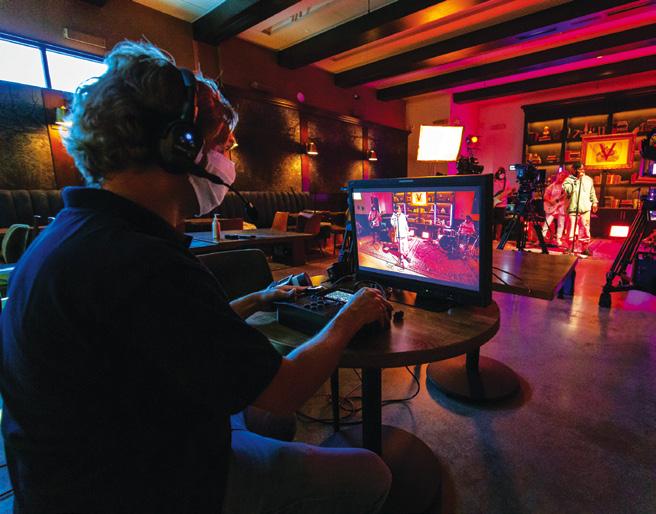
Mo-Sys and HYPER Studios launch StarTracker Sports Studio
Mo-Sys Engineering, a virtual production and image robotics company, and UK firm HYPER Studios, a cloud broadcast graphics creator, have designed StarTracker Sports Studio, the first virtual production system with datadriven sports graphics. It combines a complete virtual production system based on Epic Games’ Unreal Engine, capable of generating moving camera virtual studios, augmented reality (AR) and extended reality (xR), with a state-of-the-art HTML5 sports graphics system.
An ever-increasing number of sports broadcasters use virtual studios and AR with data-driven graphics, where each graphic type is generated by two separate graphics systems. However, rather than simply keying standard overlay graphics on top of a virtual set, sports broadcasters are now asking to integrate data-driven graphics inside the virtual studio – for example, making them appear inside a virtual monitor or synching them to an AR animation where the graphics need to match the style and branding of the AR virtual graphics.
StarTracker Sports Studio enables in-context design of photo-realistic virtual graphics with data-driven sports graphics, simplifying the creation and operation of this new approach to virtual sports graphic presentation.
“We have engaged with many sports broadcasters in order to capture the full spectrum of graphics functionality and workflows that they need now and going forwards, in order to cover major events,” said Michael Geissler, CEO of Mo-Sys. “Working with HYPER Studios, we have designed a system that allows a sports broadcaster to create integrated and in-context virtual graphics content, and as a result produce more engaging and differentiated content for their viewers.”
www.mo-sys.com
TRACAB announces release of Coach Paint 8.2
TRACAB, a ChyronHego brand, has launched Coach Paint 8.2, sports-agnostic coaching analysis software. This version enhances Coach Paint with improved timeline features and more robust formation visualisation, upgrades to flash detection, and introduces Coach Paint Training Ground, a mobile tool that makes telestration and video review immediately available to coaching teams before, during and after a match.
Coach Paint Training Ground provides access to Coach Paint software through a one-input, one-output mobile platform that allows coaching teams to instantly telestrate video, highlight coaching points and review plays. Designed for intuitive use during live play, it brings a new dimension to coaching and in-game decision-making.
Coach Paint comes complete with an array of digital tools suited to help coaches to visualise formations and players, to improve positional awareness. Using graphics and techniques familiar from live sports broadcast and analysis shows, the TRACAB software gives the coaching staff more detailed and digestible insights.
www.tracab.com
More Thunder from Sonnet’s new card reader
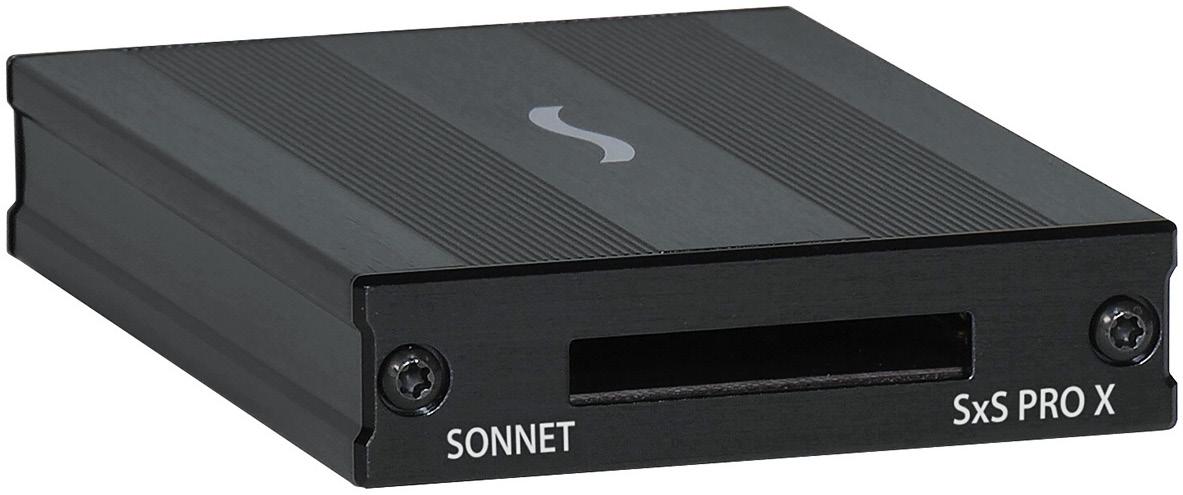
Sonnet Technologies has launched the Sonnet SxS PRO X Thunderbolt 3 single-slot card reader, the latest model in its family of professional media readers. It features a 40Gbps Thunderbolt 3 interface and is powered through the cable that connects it to the computer. SxS PRO X is the latest version of the SxS memory cards developed by Sony for use as onboard recording media in many past and current Sony and ARRI pro digital video cameras and camcorders.
Compatible with Mac and Windows computers with Thunderbolt 3 ports, the SxS PRO X card reader ingests footage from all SxS media at their maximum supported speeds. Designed for demanding workflows, it is built with a pocket-size aluminium enclosure and includes a separate Thunderbolt 3 cable. These features enable users to integrate the reader into any workspace or workflow and pack it easily into a computer bag or backpack.
SxS PRO X cards feature an upgraded interface (PCIe 3.0), enabling them to deliver speeds nearly three times as fast as the last-generation (PCIe 2.0) cards. But for a user to take advantage of the performance gains, a card reader with the new interface is also required. Not only can the Sonnet reader deliver maximum SxS PRO X ingest speeds of up to 1,250MB/s – cutting ingest time by more than half compared to previous readers – it also supports every previous generation SxS card at the card’s maximum rated speed. It also ingests from XQD and SD memory cards when used with XQD and SD card adapters (sold separately).
Measuring 2.8 inches wide by 4.1 inches long by 0.8 inches high, the Thunderbolt 3 single-slot card reader is the smallest SxS PRO X card reader available.

www.sonnettech.com
Litepanels brightens with Lykos+ mini-LED panel
Litepanels has launched the next generation of Lykos mini-LED panel lights. The new Lykos+ Bi-color LED panel is one of the smallest in the Litepanels range, but features an output 40% brighter than the previous generation, delivering 2,000 lux (@3ft/1m) of accurate white light at any colour temperature from 3,200-5,600K.
Incorporating advanced LED and lensing technology developed for Litepanels’ Astra range of 1x1 panels, Lykos+ offers broadcast-quality lighting – with a CRI of 96 for true-to-life colour accuracy – in a fixture that weighs just 500g. Lykos+ is designed for remote locations or tight spaces and provides over two hours of operation via its built-in L-series/NPF battery mount.
The mini light offers multiple mounting options or can be hand-held with a sturdy hand grip. Stand-mounted, taped or tied, Lykos+ is designed to integrate easily into any lighting scene. Brightness and colour temperature are controlled by two dials or via the Litepanels SmartLite Director iOS app with an optional Bluetooth dongle.
Lykos+ is available from Litepanels authorised retailers as either an individual fixture or as a Flight Kit incorporating three lights, stands, filters, softbox and a Peli rolling flight case.
www.litepanels.com





